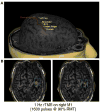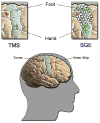Transcranial brain stimulation: clinical applications and future directions
- PMID: 21435574
- PMCID: PMC3547606
- DOI: 10.1016/j.nec.2011.01.002
Transcranial brain stimulation: clinical applications and future directions
Abstract
Noninvasive brain stimulation is a valuable investigative tool and has potential therapeutic applications in cognitive neuroscience, neurophysiology, psychiatry, and neurology. Transcranial magnetic stimulation (TMS) is particularly useful to establish and map causal brain-behavior relations in motor and nonmotor cortical areas. Neuronavigated TMS is able to provide precise information related to the individual's functional anatomy that can be visualized and used during surgical interventions and critically aid in presurgical planning, reducing the need for riskier and more cumbersome intraoperative or invasive mapping procedures. This article reviews methodological aspects, clinical applications, and future directions of TMS-based mapping.
Copyright © 2011 Elsevier Inc. All rights reserved.
Figures







Similar articles
-
Preoperative multimodal motor mapping: a comparison of magnetoencephalography imaging, navigated transcranial magnetic stimulation, and direct cortical stimulation.J Neurosurg. 2012 Aug;117(2):354-62. doi: 10.3171/2012.5.JNS112124. Epub 2012 Jun 15. J Neurosurg. 2012. PMID: 22702484 Free PMC article.
-
Clinical Applications of Transcranial Magnetic Stimulation in Pediatric Neurology.J Child Neurol. 2015 Aug;30(9):1111-24. doi: 10.1177/0883073814553274. Epub 2014 Oct 23. J Child Neurol. 2015. PMID: 25342309 Review.
-
Robot-assisted image-guided transcranial magnetic stimulation for somatotopic mapping of the motor cortex: a clinical pilot study.Acta Neurochir (Wien). 2010 Feb;152(2):333-43. doi: 10.1007/s00701-009-0565-1. Epub 2009 Nov 27. Acta Neurochir (Wien). 2010. PMID: 19943069 Free PMC article. Clinical Trial.
-
When imaging meets neurophysiology: the value of navigated transcranial magnetic stimulation for preoperative neurophysiological mapping prior to brain tumor surgery.Neurosurg Focus. 2019 Dec 1;47(6):E10. doi: 10.3171/2019.9.FOCUS19640. Neurosurg Focus. 2019. PMID: 31786549
-
[New insights into brain function by combination of transcranial magnetic stimulation and functional brain mapping].Nervenarzt. 2001 Apr;72(4):320-6. doi: 10.1007/s001150050758. Nervenarzt. 2001. PMID: 11320870 Review. German.
Cited by
-
Transcranial magnetic stimulation in neurology: A review of established and prospective applications.Neurol Clin Pract. 2013 Dec;3(6):519-526. doi: 10.1212/01.CPJ.0000436213.11132.8e. Neurol Clin Pract. 2013. PMID: 24353923 Free PMC article.
-
Localizing central swallowing functions by combining non-invasive brain stimulation with neuroimaging.Brain Stimul. 2020 Sep-Oct;13(5):1207-1210. doi: 10.1016/j.brs.2020.06.003. Epub 2020 Jun 3. Brain Stimul. 2020. PMID: 32504829 Free PMC article. No abstract available.
-
From Nose to Brain: Un-Sensed Electrical Currents Applied in the Nose Alter Activity in Deep Brain Structures.Cereb Cortex. 2016 Oct 1;26(11):4180-4191. doi: 10.1093/cercor/bhw222. Cereb Cortex. 2016. PMID: 27591145 Free PMC article.
-
Antibody-conjugated gold nanoparticles as nanotransducers for second near-infrared photo-stimulation of neurons in rats.Nano Converg. 2022 Mar 21;9(1):13. doi: 10.1186/s40580-022-00304-y. Nano Converg. 2022. PMID: 35312875 Free PMC article.
-
Transcranial Magnetic Stimulation for the Neurological Patient: Scientific Principles and Applications.Semin Neurol. 2022 Apr;42(2):149-157. doi: 10.1055/s-0041-1742265. Epub 2022 Feb 25. Semin Neurol. 2022. PMID: 35213900 Free PMC article.
References
-
- Krings T, Chiappa KH, Foltys H, et al. Introducing navigated transcranial magnetic stimulation as a refined brain mapping methodology. Neurosurg Rev. 2001;24(4):171–9. - PubMed
-
- Raichle ME. A brief history of human brain mapping. Trends Neurosci. 2009;32(2):118–26. - PubMed
-
- Bartholow R. Experimental investigations into the function of the human brain. Am J Med Sci. 1874;134:305–13.
-
- Penfield W, Rasmussen T. The cerebral cortex of man. New York: Macmillan; 1950. pp. 44–56.pp. 214–5.
Publication types
MeSH terms
Grants and funding
LinkOut - more resources
Full Text Sources
Other Literature Sources
Medical

